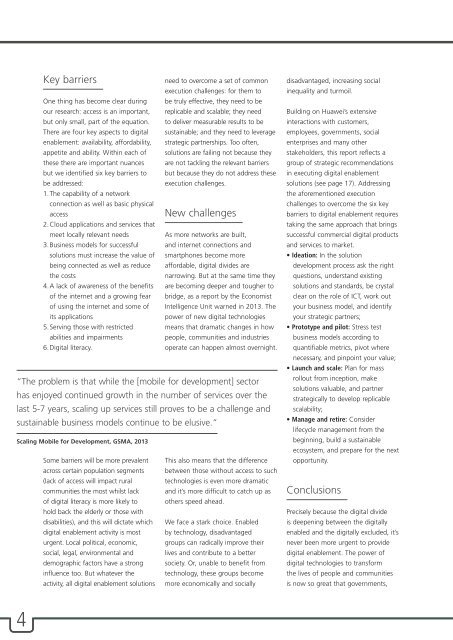Digital Enablement
1ZoIvug
1ZoIvug
Create successful ePaper yourself
Turn your PDF publications into a flip-book with our unique Google optimized e-Paper software.
Key barriers<br />
One thing has become clear during<br />
our research: access is an important,<br />
but only small, part of the equation.<br />
There are four key aspects to digital<br />
enablement: availability, affordability,<br />
appetite and ability. Within each of<br />
these there are important nuances<br />
but we identified six key barriers to<br />
be addressed:<br />
1. The capability of a network<br />
connection as well as basic physical<br />
access<br />
2. Cloud applications and services that<br />
meet locally relevant needs<br />
3. Business models for successful<br />
solutions must increase the value of<br />
being connected as well as reduce<br />
the costs<br />
4. A lack of awareness of the benefits<br />
of the internet and a growing fear<br />
of using the internet and some of<br />
its applications<br />
5. Serving those with restricted<br />
abilities and impairments<br />
6. <strong>Digital</strong> literacy.<br />
need to overcome a set of common<br />
execution challenges: for them to<br />
be truly effective, they need to be<br />
replicable and scalable; they need<br />
to deliver measurable results to be<br />
sustainable; and they need to leverage<br />
strategic partnerships. Too often,<br />
solutions are failing not because they<br />
are not tackling the relevant barriers<br />
but because they do not address these<br />
execution challenges.<br />
New challenges<br />
As more networks are built,<br />
and internet connections and<br />
smartphones become more<br />
affordable, digital divides are<br />
narrowing. But at the same time they<br />
are becoming deeper and tougher to<br />
bridge, as a report by the Economist<br />
Intelligence Unit warned in 2013. The<br />
power of new digital technologies<br />
means that dramatic changes in how<br />
people, communities and industries<br />
operate can happen almost overnight.<br />
“The problem is that while the [mobile for development] sector<br />
has enjoyed continued growth in the number of services over the<br />
last 5-7 years, scaling up services still proves to be a challenge and<br />
sustainable business models continue to be elusive.“<br />
Scaling Mobile for Development, GSMA, 2013<br />
Some barriers will be more prevalent This also means that the difference<br />
across certain population segments between those without access to such<br />
(lack of access will impact rural technologies is even more dramatic<br />
communities the most whilst lack and it’s more difficult to catch up as<br />
of digital literacy is more likely to others speed ahead.<br />
hold back the elderly or those with<br />
disabilities), and this will dictate which We face a stark choice. Enabled<br />
digital enablement activity is most by technology, disadvantaged<br />
urgent. Local political, economic, groups can radically improve their<br />
social, legal, environmental and lives and contribute to a better<br />
demographic factors have a strong society. Or, unable to benefit from<br />
influence too. But whatever the technology, these groups become<br />
activity, all digital enablement solutions more economically and socially<br />
disadvantaged, increasing social<br />
inequality and turmoil.<br />
Building on Huawei’s extensive<br />
interactions with customers,<br />
employees, governments, social<br />
enterprises and many other<br />
stakeholders, this report reflects a<br />
group of strategic recommendations<br />
in executing digital enablement<br />
solutions (see page 17). Addressing<br />
the aforementioned execution<br />
challenges to overcome the six key<br />
barriers to digital enablement requires<br />
taking the same approach that brings<br />
successful commercial digital products<br />
and services to market.<br />
• Ideation: In the solution<br />
development process ask the right<br />
questions, understand existing<br />
solutions and standards, be crystal<br />
clear on the role of ICT, work out<br />
your business model, and identify<br />
your strategic partners;<br />
• Prototype and pilot: Stress test<br />
business models according to<br />
quantifiable metrics, pivot where<br />
necessary, and pinpoint your value;<br />
• Launch and scale: Plan for mass<br />
rollout from inception, make<br />
solutions valuable, and partner<br />
strategically to develop replicable<br />
scalability;<br />
• Manage and retire: Consider<br />
lifecycle management from the<br />
beginning, build a sustainable<br />
ecosystem, and prepare for the next<br />
opportunity.<br />
Conclusions<br />
Precisely because the digital divide<br />
is deepening between the digitally<br />
enabled and the digitally excluded, it’s<br />
never been more urgent to provide<br />
digital enablement. The power of<br />
digital technologies to transform<br />
the lives of people and communities<br />
is now so great that governments,<br />
4




